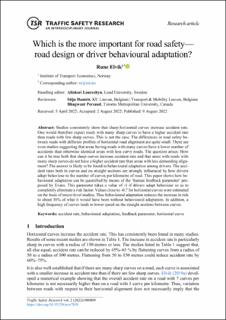| dc.contributor.author | Elvik, Rune | |
| dc.coverage.spatial | Norway, Oslo | en_US |
| dc.date.accessioned | 2023-06-16T06:44:22Z | |
| dc.date.available | 2023-06-16T06:44:22Z | |
| dc.date.created | 2022-11-04T15:43:02Z | |
| dc.date.issued | 2022-08-09 | |
| dc.identifier.citation | Traffic Safety Research (TSR). 2022, 2 1-11. | en_US |
| dc.identifier.issn | 2004-3082 | |
| dc.identifier.uri | https://hdl.handle.net/11250/3071704 | |
| dc.description | Elvik, R. (2022). Which is the more important for road safety—road design or driver behavioural adaptation?. Traffic Safety Research, 2, 000009. | en_US |
| dc.description.abstract | Studies consistently show that sharp horizontal curves increase accident rate. One would therefore expect roads with many sharp curves to have a higher accident rate than roads with few sharp curves. This is not the case. The differences in road safety between roads with different profiles of horizontal road alignment are quite small. There are even studies suggesting that areas having roads with many curves have a lower number of accidents than otherwise identical areas with less curvy roads. The question arises: How can it be true both that sharp curves increase accident rate and that areas with roads with many sharp curves do not have a higher accident rate than areas with less demanding alignment? The answer is likely to be found in behavioural adaptation among drivers. The accident rates both in curves and on straight sections are strongly influenced by how drivers adapt behaviour to the number of curves per kilometre of road. This paper shows how behavioural adaptation can be quantified by means of the ‘human feedback parameter’ proposed by Evans. This parameter takes a value of -1 if drivers adapt behaviour so as to completely eliminate a risk factor. Values close to -0.7 for horizontal curves were estimated on the basis of micro-level studies. Thus behavioural adaptation reduces the increase in risk to about 30% of what it would have been without behavioural adaptation. In addition, a high frequency of curves leads to lower speed on the straight sections between curves. | en_US |
| dc.language.iso | eng | en_US |
| dc.publisher | Lunds universitets [University Publisher], Institutionen för teknik och samhälle [Imprint] | en_US |
| dc.rights | Navngivelse 4.0 Internasjonal | * |
| dc.rights.uri | http://creativecommons.org/licenses/by/4.0/deed.no | * |
| dc.subject | accident rate | en_US |
| dc.subject | behavioural adaptation | en_US |
| dc.subject | feedback parameter | en_US |
| dc.subject | feedback parameter | en_US |
| dc.title | Which is the more important for road safety— road design or driver behavioural adaptation? | en_US |
| dc.title.alternative | Which is the more important for road safety— road design or driver behavioural adaptation? | en_US |
| dc.type | Journal article | en_US |
| dc.type | Peer reviewed | en_US |
| dc.rights.holder | © 2022 Rune Elvik | en_US |
| dc.source.articlenumber | 000009 | en_US |
| dc.description.version | publishedVersion | en_US |
| cristin.ispublished | true | |
| cristin.fulltext | original | |
| cristin.qualitycode | 1 | |
| dc.identifier.doi | 10.55329/pvir7839 | |
| dc.identifier.cristin | 2069388 | |
| dc.source.journal | Traffic Safety Research (TSR) | en_US |
| dc.source.volume | 2 | en_US |
| dc.source.pagenumber | 1-11 | en_US |

